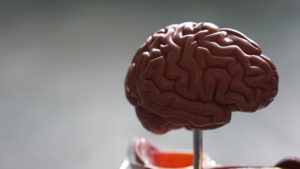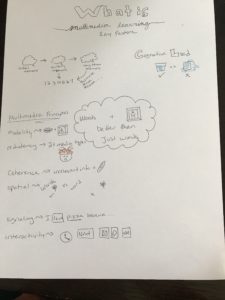The Podcast “Multimedia Design for Learning- Overview” by Kevin Alexander was a synthesized explanation of what Multimedia learning and instruction is, why it is important and how as a teacher you can use the principles to decide if a source is a good use of multimedia learning or how to successfully create your own. Alexander explained how Mayer used an alternative way to research that measured a student’s transfer of knowledge rather than their retention.  This research, being the basis for multimedia in modern education, shows how education has shifted from the IQ based testing and standardized testing, emphasizing retention of information, to the now more popular lack of testing or inquiry-based learning experiences. The shift in modern education has emphasized students understanding a subject and being able to apply it to new situations and examples or as Mayer put it, the transfer of knowledge. Through his, Mayer’s, innovative research he was able to create principles of multimedia learning that help teachers create and select multimedia learning opportunities that are beneficial, successful
This research, being the basis for multimedia in modern education, shows how education has shifted from the IQ based testing and standardized testing, emphasizing retention of information, to the now more popular lack of testing or inquiry-based learning experiences. The shift in modern education has emphasized students understanding a subject and being able to apply it to new situations and examples or as Mayer put it, the transfer of knowledge. Through his, Mayer’s, innovative research he was able to create principles of multimedia learning that help teachers create and select multimedia learning opportunities that are beneficial, successful , and innovative for their learners. Alexander also explained the extraneous, essential, and generative information aspect. This is one thing that many of my instructors have struggled with in their PowerPoint presentations. Being able to eliminate unnecessary info (extraneous), provide and impart the essential information, and being able to help make connections to previous learning.
, and innovative for their learners. Alexander also explained the extraneous, essential, and generative information aspect. This is one thing that many of my instructors have struggled with in their PowerPoint presentations. Being able to eliminate unnecessary info (extraneous), provide and impart the essential information, and being able to help make connections to previous learning.
The video “What is Multimedia Learning? What is Multimedia?” by Ray Pastore, in my option, did a great job of explaining the concepts, but did not put them into practice well. He had too much excess information, too much text, and narration overlap and did not apply the coherence principle (Mayer, 2014). One anecdote that he shared was an HR presentation that included different airplane pictures on each slide . Pastore explained how this was distracting. In his video, I found the same thing with the introduction of all the heart pictures, lots of text, him narrating, and being in the frame. It was all a bit much.
. Pastore explained how this was distracting. In his video, I found the same thing with the introduction of all the heart pictures, lots of text, him narrating, and being in the frame. It was all a bit much.
Finally, sketch noting. This is something that I explored a little bit in high school. I learned roman style outlined Cornell notes as my main form of note-taking and it is one that I used for a long time. Now I typically take bullet point style notes with arrows, abbreviations, indents, and sometimes drawings, graphs, or symbols mixed in. Sketch noting was introduced in my grade 10 history class and I tried using it on multiple chapters of the textbook. I found that, at least for me, it slowed me down way to much, lead to less retention of knowledge, and I ended up not including as much information as I should have just for lack of space. Through this process and trying it multiple other times  I found that for short articles it can work or short videos, or as a way of synthesizing my written notes, but as my primary note-taking technique it does not work. It is a way for me to review my notes and actively make connections and create pictures that can jog my memory on a test or essay. This being said I do think it is a great alternative for some people who may think more creatively. Sketch noting can be beneficial for some to hone in on the important information.
I found that for short articles it can work or short videos, or as a way of synthesizing my written notes, but as my primary note-taking technique it does not work. It is a way for me to review my notes and actively make connections and create pictures that can jog my memory on a test or essay. This being said I do think it is a great alternative for some people who may think more creatively. Sketch noting can be beneficial for some to hone in on the important information.
Below is a picture of my Sketch notes that are a synthesized version of my written notes.

Alexander , K. (2017). Retrieved from https://soundcloud.com/user-433569679/multimedia-design-for-learning-overview
Mayer, R. (2014). Introduction to Multimedia Learning. In R. Mayer (Ed.), The Cambridge Handbook of Multimedia Learning (Cambridge Handbooks in Psychology, pp. 1-24). Cambridge: Cambridge University Press. doi:10.1017/CBO9781139547369.002
Pastore, Ray.(2018, August 16).What is Multimedia Learning? What is Multimedia? [Video]. YouTube.https://www.youtube.com/watch?v=g-sknUVq1mk&feature=emb_title

Leave a Reply
You must be logged in to post a comment.